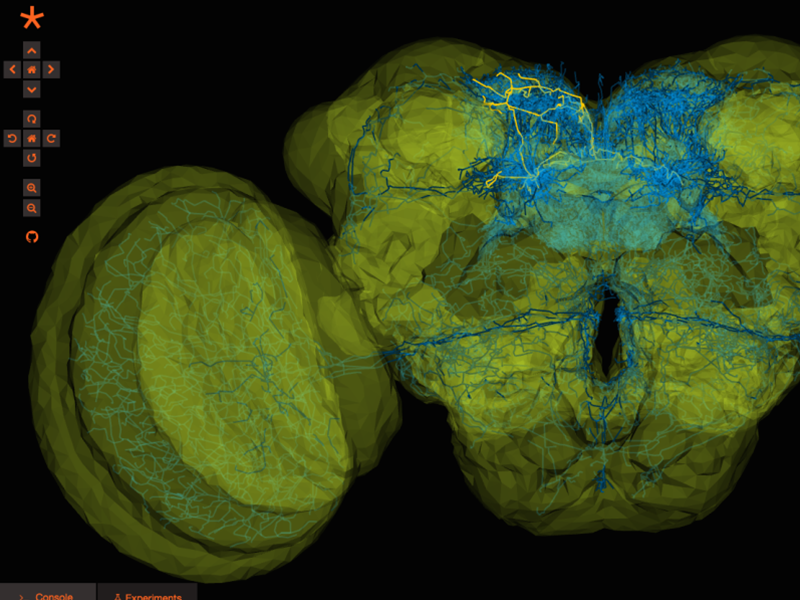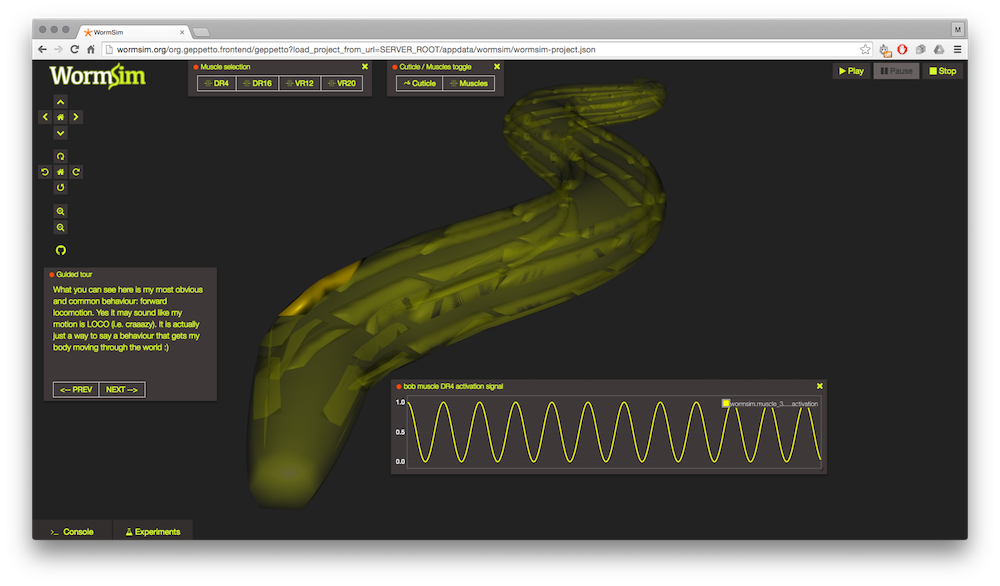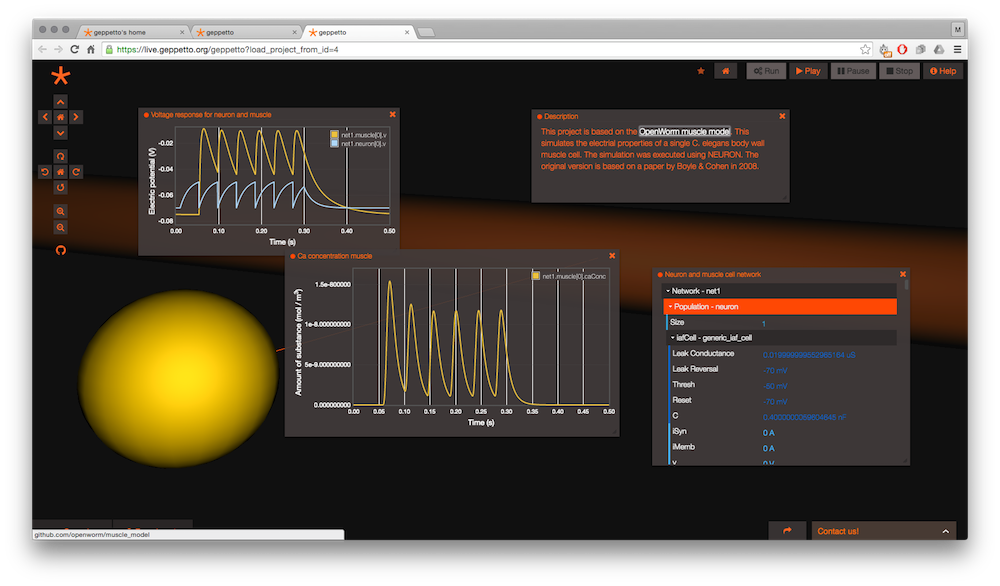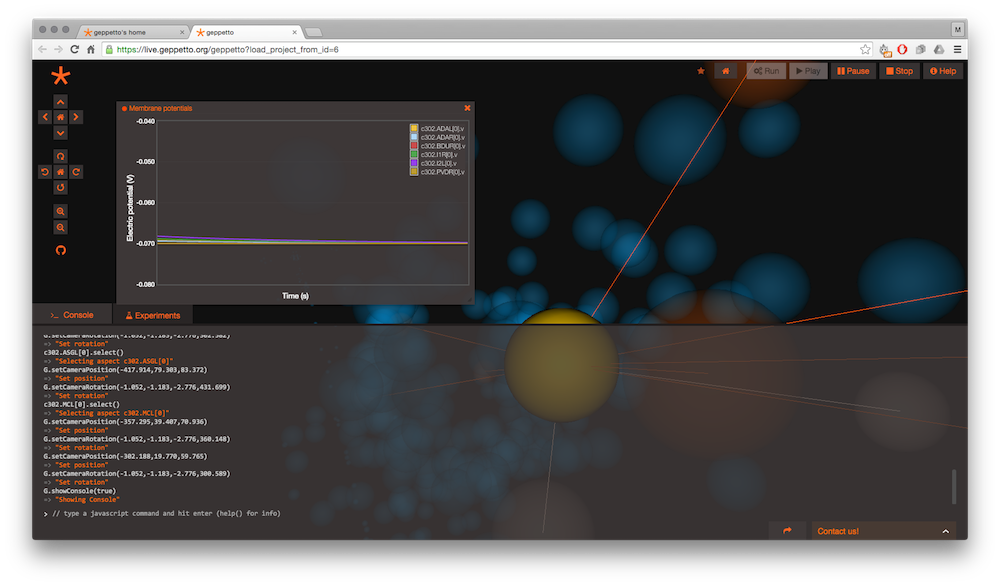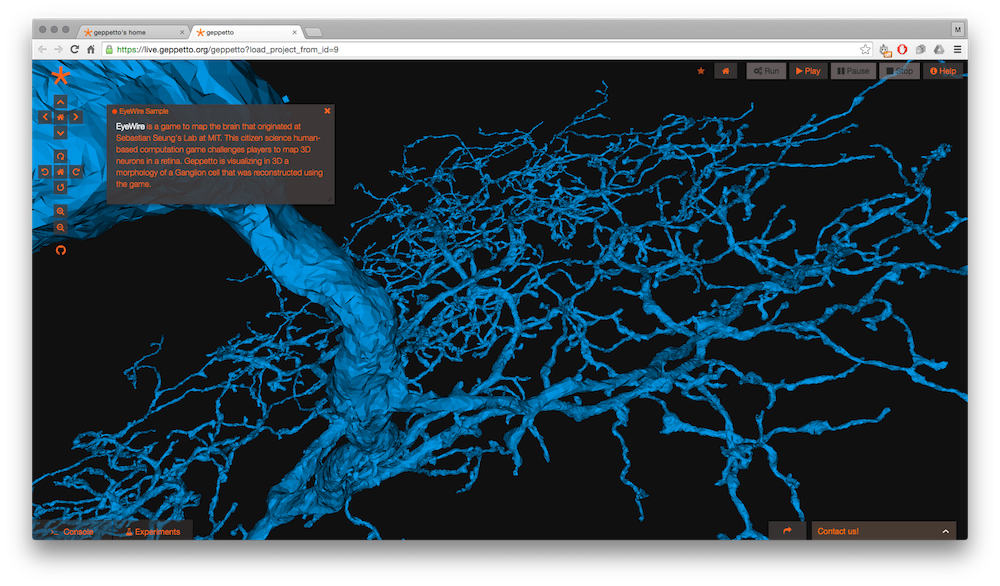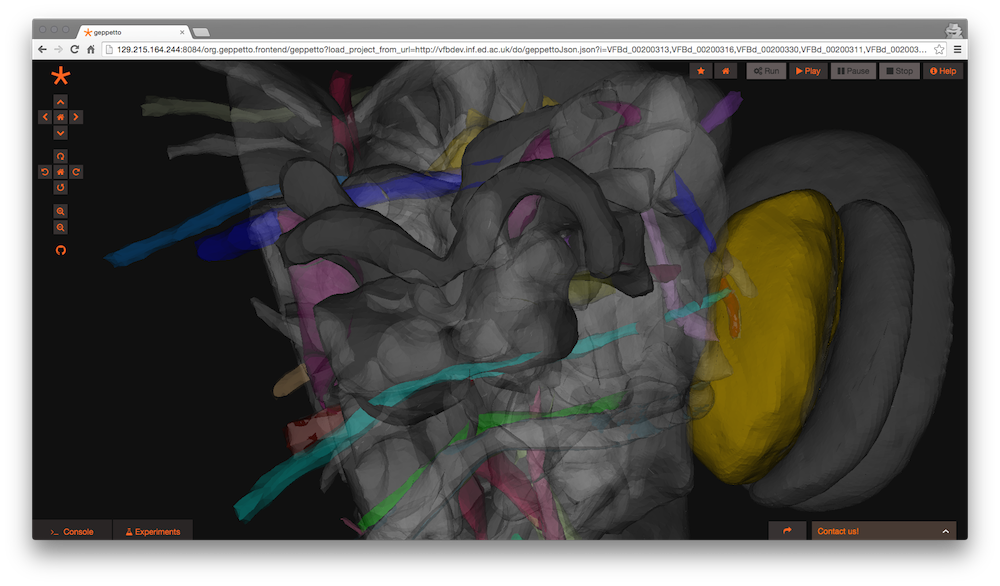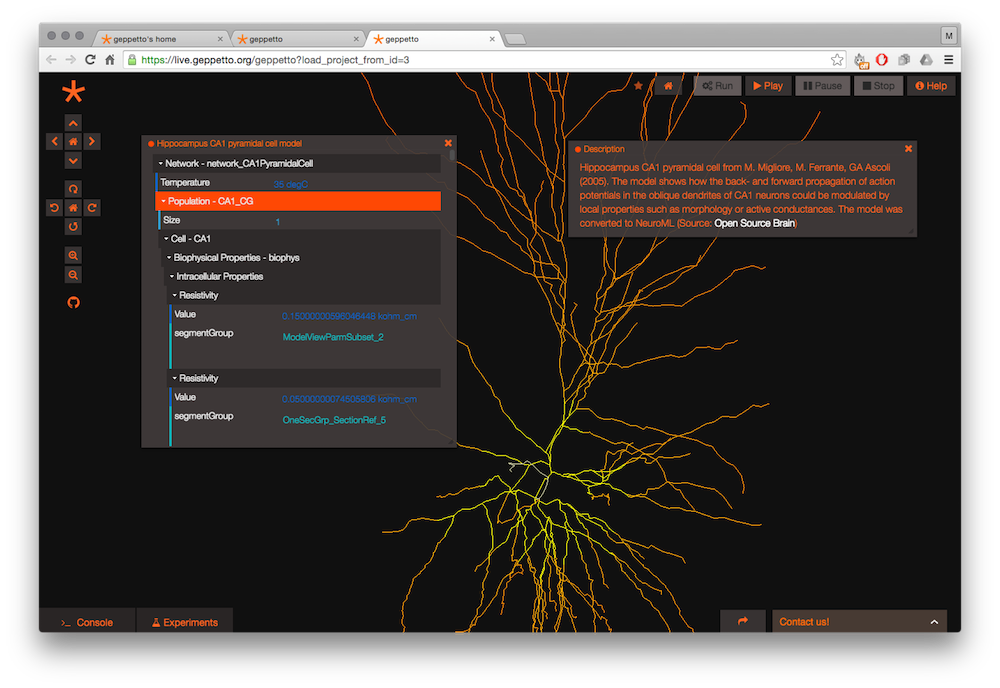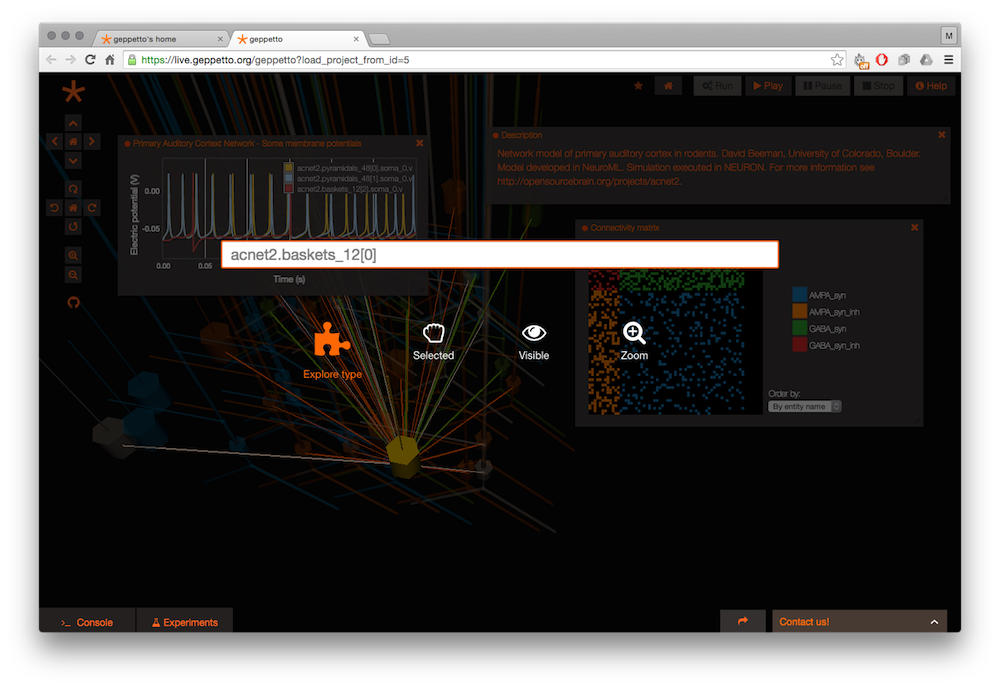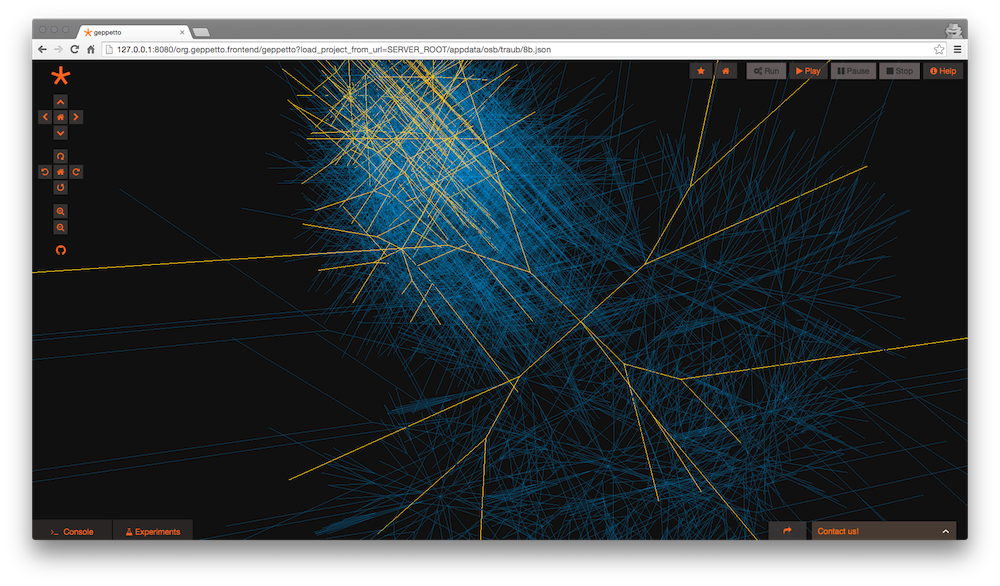Geppetto is an open source project that VFB is an active developer of in partnership with MetaCell
For full details on the project see Geppetto.org
Geppetto
Build robust neuroscience applications.
| Live demo | Paper | Docs |
The visualisation and simulation platform focused on what matters to you.
Neuroscience software reimagined
Geppetto is a web-based visualisation and simulation platform to build neuroscience software applications. Reuse best practices, best compomnents, best design. Don’t reinvent the wheel.
A completely modular platform.
Engineered together with scientists, Geppetto lets you integrate different data and models. A modular architecture allows the platform to easily support different standard formats for both experimental and computational data.
An open-source revolution.
Geppetto is entirely open source and engineers, scientists and developers from different research groups are contributing to its development by adding functionality to visualize and simulate new data and models.
Awesome in-browser 3D
Geppetto enables visualizing and interacting with 3D data in your web browser. Take advantage of out of the box support for point clouds, ball-and-stick models, line segments for large networks or arbitrarly complex meshes.
Extensible components based framework
A modular system of components allows both experimental and simulated data to be visualized in domain specific ways so that you can always be in control of how to present your data.
Fully indexed and searchable data and models
The data and models loaded inside Geppetto are fully indexed and searchable for you to always find what is most important without big data getting in the way.
Dynamic visualisation
We know you are used to look at your simulations only via a plot or a static rendered video. In Geppetto the 3D models can be linked to your simulation to add a dynamic visual component to your computational experiments.
A powerful abstraction
Geppetto defines a model abstraction capable of representing different classes of models and data, in a generic way. In this way the platform can be used over and over by different groups, becoming more and more robust, generic and smart.
Features
Some of the features responsible for giving you an amazing experience.
Regular releases of Geppetto make sure components keep being updated and tested.
Help us identify what matters to you and what you would want to see built in Geppetto. Do so by logging an enhancement request on GitHub or dropping us an email.
Curious to know more about Geppetto?
Gallery
Some screenshots of what is possible today. Imagine the future.
Get involved!
Help us build the next generation simulation platform!
Geppetto is entirely open source and is being built by a growing community of talented engineers and scientists. Geppetto uses different languages to achieve different goals. Geppetto runs on the Eclipse Virgo WebServer and can be deployed on different infrastructures including cloud-based ones like Amazon EC2.
Geppetto is multi-platform and works on Linux, Mac OSX and Windows, so no matter on what platform you develop there is a way for you to run it and add fantastic contributions.
Show me the code!
Right! Geppetto is hosted on GitHub, every module has its own repository to provide flexible ways of branching individual components. For every module we have at least two branches, development and master. The development branch gets merged into master each monthly release. If you want to contribute you can either go straight to the code or reach out to us dropping an email, we will show you around and help you contribute in your favorite way!
| Source code | Docs | Development board
F.A.Q.
Find some answers to the most common questions about Geppetto!
Who is building Geppetto?
Many engineers and scientists contribute every day to the development of Geppetto, a big thank to our superheroes:
- Matteo Cantarelli (Coordinator, principal architect, engineer)
- Giovanni Idili (Architect, engineer)
- Afonso Pinto (Engineer)
- Adrian Quintana Perez (Architect, engineer)
- Boris Marin (Architect, computational scientist)
- Dario Del Piano (Engineer)
- Facundo Rodriguez (Engineer)
- Filippo Ledda (Architect, engineer)
- Jesus Martinez (Engineer)
For the full list of contributors see here.
Why are you building Geppetto?
Read our paper to learn more.
Besides the functional requirements, Geppetto’s goal is to move away from the monolithic approach to software that is usually found in academic programming projects.
Computational neuroscience has produced software systems, including NEURON and Genesis, that are extremely useful for simulating systems of neurons that include biophysical details (Brette et al, 2007). A range of other algorithms have been devised in other areas of computational biology (Barnes & Chu, 2010) for which simulators have been produced (Takahashi, 2004). Several investigations have pointed to the challenges in building a single system that integrates multiple simulation algorithms together into a single biological model (Takahashi et al., 2002, Dada and Mendes, 2007, Cornelis et al., 2012).
Geppetto aims to address these scientific and engineering challenges. Geppetto’s design leverages cutting edge software technologies. Its architecture and development follows industry standards.
How is Geppetto development funded?
Building great software takes time. And money. Geppetto is no exception and as many open-source projects it is funded by a hybrid model. Geppetto’s development is supported by both awesome volunteer contributors and by external companies and organisations:
- OpenWorm
- MetaCell
- Wellcome Trust via the Open Source Brain initiative
- Wellcome Trust via Virtual Fly Brain
- Orion Bionetworks
Commercial companies, academic institutions and independent research labs are welcome to get in touch with us to discuss collaborations and grant applications.
What is Geppetto’s relationship with OpenWorm?
The decision to build Geppetto came after an analysis of the requirements for a platform able to support the OpenWorm full-scale simulation of the C. elegans.
Geppetto’s architecture is generic and therefore the simulation of the C.elegans is just one specific simulation it is capable of. Geppetto’s modules can be built to simulate and integrate any complex system.
What license does Gepetto have?
Geppetto is released under the MIT license.
 Arr, didn’t find what you were looking for? Check out our docs
Arr, didn’t find what you were looking for? Check out our docs
